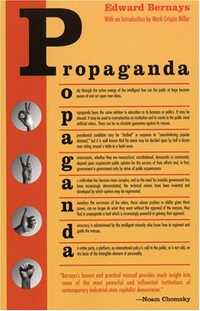
Propaganda
Chapter 10
Art and Science
- Author :: Edward Bernays
- Publication Year :: 1928
- Posted: August 25, 2024
Important
Very important
Chapter 10 - Art and Science
page 135:
-
In art as in politics the minority rules but it can rule only by going out to meet the public on its own ground, by understanding the anatomy of public opinion and utilizing it.
-
We see this today with the same language of “minorities.” Politicians today, and businesses, don’t cater to the masses, they target subset minorities and deliver tailored messages that resonate with that particular group specifically. The politician will talk about cutting taxes for business owners, expanding welfare to the poor, wiping out student debts to the recent graduates, or abortion to the feminists. By convincing each minority group that they will be represented in their lynch pin issues, the politician secures the majority vote. In the end, it was almost certainly all lies, but it landed them the votes.
-
In applied and commercial art, propaganda makes greater opportunities for the artist than ever before. This arises from the fact that mass production reaches an impasse when it competes on a price basis only. It must, therefore, in a large number of fields create a field of competition based on esthetic values.
-
Artists can lend aesthetic values by literally making the products look better. This differentiation can allow one product to sell for more than another functionally identical product.
page 136:
-
Propaganda can play a part in pointing out what is and what is not beautiful, and business can definitely help in this way to raise the level of American culture. In this process propaganda will naturally make use of the authority of group leaders whose taste and opinion are recognized.
-
For instance, in the manufacture of American silk, markets are developed by going to Paris for inspiration. Paris can give American silk a stamp of authority which will aid it to achieve definite position in the United States.
-
Again we see how even irrelevant opinions, such as silk vs wool, and subjective opinions like what is beautiful (though there, I think, is a large degree of objectivity here) are molded by the propagandists. I am belaboring the point, but Bernays is perfectly on point when he says in chapter 1 that “We are governed, our minds are molded, our tastes formed, our ideas suggested, largely by men we have never heard of."
-
The next few pages recount such a propaganda event where American silks are displayed in Paris’ Louvre.
page 138:
-
The result of this ceremony was that prominent department stores in New York, Chicago and other cities asked to have this exhibition. They tried to mold the public taste in conformity with the idea which had the approval of Paris. The silks of Cheney Brothers—a commercial product produced in quantity—gained a place in public esteem by being associated with the work of a recognized artist and with a great art museum.
-
The same can be said of almost any commercial product susceptible of beautiful design. There are few products in daily use, whether furniture, clothes, lamps, posters, commercial labels, book jackets, pocketbooks or bathtubs which are not subject to the laws of good taste.
page 139:
-
When Secretary Hoover, three years ago, was asked to appoint a commission to the Paris Exposition of Decorative Arts, he did so. As Associate Commissioner I assisted in the organizing of the group of important business leaders in the industrial art field who went to Paris as delegates to visit and report on the Exposition. The propaganda carried on for the aims and purposes of the Commission undoubtedly had a widespread effect on the attitude of Americans towards art in industry; it was only a few years later that the modern art movement penetrated all fields of industry.
-
Department stores took it up. R. H. Macy & Company held an Art-in-Trades Exposition, in which the Metropolitan Museum of Art collaborated as adviser. Lord & Taylor sponsored a Modern Arts Exposition, with foreign exhibitors. These stores, coming closely in touch with the life of the people, performed a propagandizing function in bringing to the people the best in art as it related to these industries. The Museum at the same time was alive to the importance of making contact with the public mind, by utilizing the department store to increase art appreciation.
-
So we see again, as with the silk or pianos, how the consumer can be propagandized into far more than buying product X or Y. Entire cultures and aesthetics can be shifted with adroit use of propaganda. Now imagine how politics and policies, social norms and taboos, or values and ethics can be manipulated in a similar fashion.
-
Of all art institutions the museum suffers most from the lack of effective propaganda. Most present-day museums have the reputation of being morgues or sanctuaries, whereas they should be leaders and teachers in the esthetic life of the community. They have little vital relation to life.
page 140:
- The treasures of beauty in a museum need to be interpreted to the public, and this requires a propagandist. The housewife in a Bronx apartment doubtless feels little interest in an ancient Greek vase in the Metropolitan Museum. Yet an artist working with a pottery firm may adapt the design of this vase to a set of china and this china, priced low through quantity production, may find its way to that Bronx apartment, developing unconsciously, through its fine line and color, an appreciation of beauty.
page 141:
-
It is not merely a question of making people come to the museum. It is also a question of making the museum, and the beauty which it houses, go to the people.
-
The museum’s accomplishments should not be evaluated merely in terms of the number of visitors. Its function is not merely to receive visitors, but to project iself and what it stands for in the community which it serves.
-
Public places, like museums and libraries, have certainly been harnessed in regard to modern propaganda. If increased traffic were the goal, that wouldn’t be so bad, but if the goal is to interpret beauty to the public then we are in the realm of manipulation. Further we see countless events where agendas are pushed by these types of organizations. A simple example would be the drag queen story time events often held in libraries. Like, why not have a story hour without drag queens? What benefit is there in having a drag queen do the reading? If you want to make it more attractive to children, you could have a clown or a cartoon character do the reading. The only reason for a drag queen as far as I see it is to normalize LGBT behavior among youngsters as their world view is still pliable.
-
The museum can stand in its community for a definite esthetic standard which can, by the help of intelligent propaganda, permeate the daily lives of all its neighbors. Why should not a museum establish a museum council of art, to establish standards in home decoration, in architecture, and in commercial production?
-
What benefits are there to standardizing home decoration? I can see architecture and production standards as being useful in numerous ways, but home decoration? One benefit would be that home decor could be mass produced, since everyone will be on the same aesthetic standard. This doesn’t benefit the people per se, their tastes are molded like their other opinions so that the producers of decor can more easily deliver a profitable product. If there were no standards, each house could be decorated individually and would support a broader but shallower producer class. I think some current (2024) examples of this would be the minimalism and farmhouse aesthetics that are popular today.
-
A recent annual report of an art museum in one of the large cities of the United States, says: “An underlying characteristic of an Art Museum like ours must be its attitude of conservatism, for after all its first duty is to treasure the great achievements of men in the arts and sciences.”
-
Is that true? Is not another important duty to interpret the models of beauty which it possesses?
page 142:
-
As in art, so in science, both pure and applied. Pure science was once guarded and fostered by learned societies and scientific associations. Now pure science finds support and encouragement also in industry. Many of the laboratories in which abstract research is being pursued are now connected with some large corporation, which is quite willing to devote hundreds of thousands of dollars to scientific study, for the sake of one golden invention or discovery which may emerge from it.
-
The industrial interests can furnish to the schools, the colleges and the postgraduate university courses the exact truth concerning the scientific progress of our age. They not only can do so; they are under obligation to do so. Propaganda as an instrument of commercial competition has opened opportunities to the inventor and given great stimulus to the research scientist. In the last five or ten years, the successes of some of the larger corporations have been so outstanding that the whole field of science has received a tremendous impetus. The American Telephone and Telegraph Company, the Western Electric Company, the General Electric Company, the Westinghouse Electric Company and others have realized the importance of scientific research. They have also understood that their ideas must be made intelligible to the public to be fully successful. Television, broadcasting, loud speakers are utilized as propaganda aids.
-
We see here more feedback where industries use research from colleges to produce new products and then those systems are fed back into the colleges. Then a point is reached where the de facto education and public research facilities are functionally employed by the corporate producers to do research that might lead to discoveries that are profitably marketable. How many courses of (pure?) research are left unexplored because there seems to be no profitable inventions that lie down that path? How many disease treatments do we have versus cures? Planned obsolescence comes to mind here. Or the mostly pointless incremental gains in things like computers and smartphones.
-
Propaganda assists in marketing new inventions. Propaganda, by repeatedly interpreting new scientific ideas and inventions to the public, has made the public more receptive. Propaganda is accustoming the public to change and progress.
-
This is beyond the study here, but I think our universities and research facilities are quite hampered by the need to make everything profitable. Consider how widely used RSA encryption is used. Every secure website you visit uses it. When it was invented, there was no real commercial application. Yet, here we are with it as the backbone of all e-commerce today. Sometimes usefulness can be found in unexpected places.
-
As long as the corporate interests are employing propaganda we will only ever get what they want to sell. And instead of taking customer requests as feedback on what to make, they will continue to mold our opinions to buy what they want to sell.
-
And again I come back to the more important side of what propaganda can do: cultural and political change. Even if the products and services sold to us by these corporations are utilizing manufactured demand, it is not the biggest problem. When you start to producing and applying manufactured cultural, ethical, or political “products” you run the risk of losing your cultural identity to the propagandists. One might argue that not all change is bad, and I would agree when that change comes from the people organically, but when the change is adopted via manipulation and propaganda it is no longer the will of the people. The very last sentence supports my position that propaganda is being used this way: “Propaganda is accustoming the public to change and progress."




